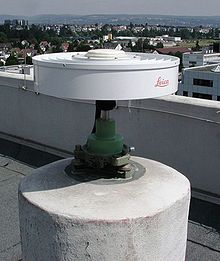Choke ring antenna


A choke ring antenna is a particular form of omnidirectional antenna for use at high frequencies (VHF & UHF). It consists of a number of conductive concentric cylinders around a central antenna. Due to its intricate construction, it is often enclosed in a protective cover or radome when placed outside and exposed to the elements.
Benefits[]
Choke ring antennas are notable for their ability to reject multipath signals from a source. Since the path that a signal takes from a transmitter to receiver can be used to measure the distance between the two, this makes it highly suited for GPS and radar applications. In a GPS ground-based receiver, a choke ring antenna can provide millimeter precision measurements[2] for use in surveying and geological measurements.
The choke ring design was originally developed at the Jet Propulsion Laboratory.[3]
See also[]
- Trimble Inc. - one manufacturer of this product.
- Patch antenna - another antenna for GPS applications.
- Magellan Navigation - another manufacturer of this product.
Notes[]
- ^ "U.S. Patent 6,040,805 – Low Profile Ceramic Choke". – Patent for a Low Profile Ceramic Choke, one specific type of choke ring antenna.
- ^ "Trimble choke ring antenna". Trimble catalog page.
- ^ "Single-depth low multipath choke ring antenna". javad.com. - A basic description of choke ring antenna benefits and limitations.
External links[]
- "Choke ring theory". javad.com. - Basic choke Ring theory of operation.
- Radio frequency antenna types
- Antennas (radio)
- Engineering stubs
- Radio communications stubs